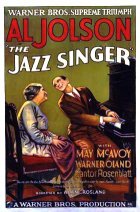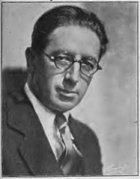
The Jazz Singer
- UNRATED
- Year:
- 1927
- 88 min
- 1,327 Views
TITLE 1:
The New York ghetto, the daily life of whichthrobs to the rhythm of music that is as old as
civilization.
FADE IN:
1. EXT. NEW YORK STREET LONG SHOT
It is a typical East Side business street at the height of the day's
activities, a street that is lined with pushcarts, sidewalk vendors and
little stores, with its milling shoppers, its petty marketing arguments,
its unkempt kids playing in the street heedless of consequences. In the
distance is seen an elevated train flashing across the background like
a comet across the sky.
2.MOVING SHOT SAME
A shot may be made from an auto or truck down the street showing the
teeming life of the ghetto. As the camera reaches a street intersection,
a half dozen kids come into the scene.
3.MED. SHOT KIDS (STUDIO STREET)
They are playing tag on the intersecting street which is given over to
tenements. There are no pushcarts and only a few stores in the basements
or ground floors of the buildings which house many thousands of ghetto
folk. The kids are attracted to something. They all look down the street
and then start running in the direction they have been looking. Some
little girls join them. (Vitaphone street piano, at some distance.)
In front of a low brick building is an Italian with a street piano and
he is grinding out that always popular classic of the East Side, "The
Sidewalks of New York." The kids come into the scene and gather around
the hurdy-gurdy.
5.CLOSE-UP GROUP
The Italian smiles as the children start dancing about. He looks
expectantly at the windows above him and nods pleasantly to someone up
above as he continues cranking the piano.
Looking upward from the street piano. This may be a very effective shot.
In several of the windows women are looking down at the music-maker and
other heads appear in other windows. Several take deliberate aim and
toss coins to the street.
7.CLOSE-UP ITALIAN
He holds out his ragged cap and expertly catches several coins without
once taking his hand from the crank of the street piano. The piece ends.
He pulls a little lever and starts turning on another selection -- some
old operatic favorite like the "Intermezzo" from Cavalleria Rusticana.
He starts moving down the street as he plays.
As the street piano, still in operation, goes down the street, the group
of kids, now much larger, follows along. The Italian stops in front of
another building, which adjoins the Orchard Street synagogue.
It bears the name, in Hebrew, of the temple. Several children get up on
the steps in front of the closed doors to listen to the music, which is
approaching. Next door is an old brownstone front, before which the
Italian stops. Underneath is a store, and in the flat over the store
live Cantor Rabinowitz and his family.
10.INT. ROOM IN SYNAGOGUE
Full shot of the little anteroom in which the rabbi holds school for the
children of the congregation and in which the cantor teaches the boys of
the choir the songs and chants of the orthodox -- the prayers set to
music that has been handed down for generations. Several boys are seated
on a bench beside a battered old square piano (one of the old square
Knabes may be obtained here). The sound of the street piano comes
through the open window, and the kids rush to the window. They no sooner
get to it and climb up to look out when the door into the room from the
synagogue proper slowly opens and the head of the venerable Cantor
Rabinowitz appears.
TITLE 2:
Cantor Rabinowitz, who sang and taught theyouth of his congregation to sing the age-old
songs of Judea -- a man revered and respected
by all the ghetto.
11.CLOSE-UP CANTOR
He peers into the room to see if his class is ready for him. He has some
difficulty in finding them. Finally he discovers them at the window. He
lifts his head as he hears the strains from the street piano, and a look
of disgust comes to him. He closes the door behind him and starts in
with a determined look.
11A.REVERSE SHOT BOYS
They are packed in the window, patched pants seats and legs only being
visible.
12.EXT. MED. SHOT
The Italian is now in front of the synagogue and is grinding out another
tune while the children dance about the discordant instrument.
The four or five boys are jammed into the open window, some of them half
way out with feet sticking almost straight out backward. With determined
tread the cantor comes up behind them and starts yanking them out of the
window. They are badly frightened and duck as the cantor cuffs them
right and left.
14.FULL SHOT ROOM
The boys, some of them propelled from behind by the irate cantor,
scramble for their seats. The cantor starts to come after them, then the
strains of the music assault his delicate ear and he turns instead to
the window.
15.CLOSE-UP CANTOR
He takes hold of the window and yanks it down roughly as though he
cannot shut out the sound from without quickly enough. (Vitaphone music
quickly dimmed to just a faint sound.) Then he turns and faces the boys.
He looks them over, muttering to himself imprecations on the terrible
sounds from without -- an insult to his musically attuned ear.
The boys straighten up with solemn looks on their faces as the cantor
looks them over scowlingly.
17.EXT. STREET OUTSIDE TEMPLE LONG SHOT
The Italian and his piano are disappearing in the distance, and a group
of boys are playing ball in the street. One is batting.
18.INT. CANTOR CLOSE-UP
He is looking at the boys as he says:
TITLE 3:
"Where is Jakie, my son?"19.FULL SHOT ROOM
The cantor is in the foreground addressing the boys. As he finishes the
question one of the boys starts to answer it. The old man suddenly jumps
around and looks up in back of him.
20.CLOSE-UP WINDOW
There is a big round hole in the window.
21.CLOSE-UP CANTOR
He looks down at the glass on the floor, then stoops and picks up a ball
from the floor. He shakes his head ominously. He scowls at the kids,
22.CLOSE-UP AT DOOR
It is opening cautiously and the black curly head of a boy of about
thirteen appears. He enters hesitatingly and fearfully of the possible
consequences.
23.FULL SHOT ROOM
The kids all look from father to son expectantly, each hoping that Jakie
will get a licking as soon as possible. The cantor comes toward the boy,
his brows knitted in a deep frown. Jakie starts toward his father
repeating, "I couldn't help it -- I didn't mean to hit it so hard --
honest I didn't." They meet in the center of the room, the boy still
protesting half tearfully. The old man brings back his arm as though to
strike him.
24.CLOSE SHOT BOTH
As the cantor brings back his arm, Jakie shuts his eyes and ducks, but
the cantor reconsiders and brings the hand down alongside without
striking the boy. He waves him to his seat on the bench with a half-
uttered threat to "fix him good the next time."
25.FULL SHOT ROOM
The cantor turns from Jakie with an impatient gesture and lines the boys
up for their lesson. He calls them to attention, then tells them to
listen to what he is going to sing. He walks to the piano and poises a
hand over the keys.
26.CLOSE-UP CANTOR
He strikes a note to give him the key he wants but the piano is
evidently out of tune. He shakes his head disgustedly, then takes an
old-fashioned tuning fork out of his inside coat pocket and strikes it
on the side of the piano, then holds it to his ear. He sings the note
and then indicates to the boys that they are to follow him as he sings.
The cantor is singing and one of the boys is paying no attention. He is
looking around toward the window longingly. The cantor, still singing,
walks over to him and cuffs him on the ear.
The boy ducks a second swipe. The cantor glares at him and demands that
he give his undivided attention to the lesson.
They are singing but taking in the scene on the side. They grin at each
other in joy at their companion's trouble, then they quickly turn their
eyes forward and sing more lustily as they feel the cantor's eyes on
them.
30.FULL SHOT ROOM
The cantor takes his place again. He shows his disgust with the manner
in which the boys are singing and, with an impatient gesture, he stops
and tells them to go home.
31.CLOSE-UP CANTOR
He waves them away, saying:
TITLE 4:
"Go now, you sound like crazy cats cryingalready."
32.MED. SHOT GROUP
The cantor finishes his dismissal and as the boys, including Jakie,
start for the door, he stops his son. Jakie, with a crestfallen look,
follows with his eyes the disappearing figures of his playmates, who
quickly exit. His father calls him and he comes opposite him and looks
up rather sullenly for the scolding he expects.
The cantor looks down at Jakie with a scowl and starts berating him. He
points to the window and his anger again rises. Jakie starts backing
away as though expecting violence. The old man gets himself together and
his attitude changes from anger to sadness. He says to the boy:
TITLE 5:
"A fine cantor you are going to be -- smeshingsynagogue windows yet!"
The boy looks up at him with an effort, which reflects something of the
length of time he has thought about this unpleasant future. He blurts
out:
TITLE 6:
"But Papa, I don't want to be no cantor."
Translation
Translate and read this script in other languages:
Select another language:
- - Select -
- 简体中文 (Chinese - Simplified)
- 繁體中文 (Chinese - Traditional)
- Español (Spanish)
- Esperanto (Esperanto)
- 日本語 (Japanese)
- Português (Portuguese)
- Deutsch (German)
- العربية (Arabic)
- Français (French)
- Русский (Russian)
- ಕನ್ನಡ (Kannada)
- 한국어 (Korean)
- עברית (Hebrew)
- Gaeilge (Irish)
- Українська (Ukrainian)
- اردو (Urdu)
- Magyar (Hungarian)
- मानक हिन्दी (Hindi)
- Indonesia (Indonesian)
- Italiano (Italian)
- தமிழ் (Tamil)
- Türkçe (Turkish)
- తెలుగు (Telugu)
- ภาษาไทย (Thai)
- Tiếng Việt (Vietnamese)
- Čeština (Czech)
- Polski (Polish)
- Bahasa Indonesia (Indonesian)
- Românește (Romanian)
- Nederlands (Dutch)
- Ελληνικά (Greek)
- Latinum (Latin)
- Svenska (Swedish)
- Dansk (Danish)
- Suomi (Finnish)
- فارسی (Persian)
- ייִדיש (Yiddish)
- հայերեն (Armenian)
- Norsk (Norwegian)
- English (English)
Citation
Use the citation below to add this screenplay to your bibliography:
Style:MLAChicagoAPA
"The Jazz Singer" Scripts.com. STANDS4 LLC, 2025. Web. 22 Feb. 2025. <https://www.scripts.com/script/the_jazz_singer_878>.







Discuss this script with the community:
Report Comment
We're doing our best to make sure our content is useful, accurate and safe.
If by any chance you spot an inappropriate comment while navigating through our website please use this form to let us know, and we'll take care of it shortly.
Attachment
You need to be logged in to favorite.
Log In